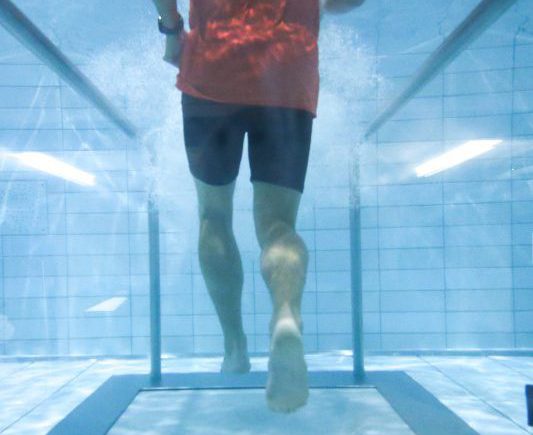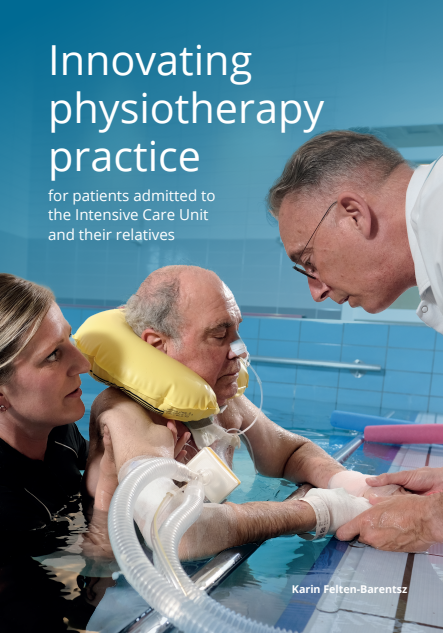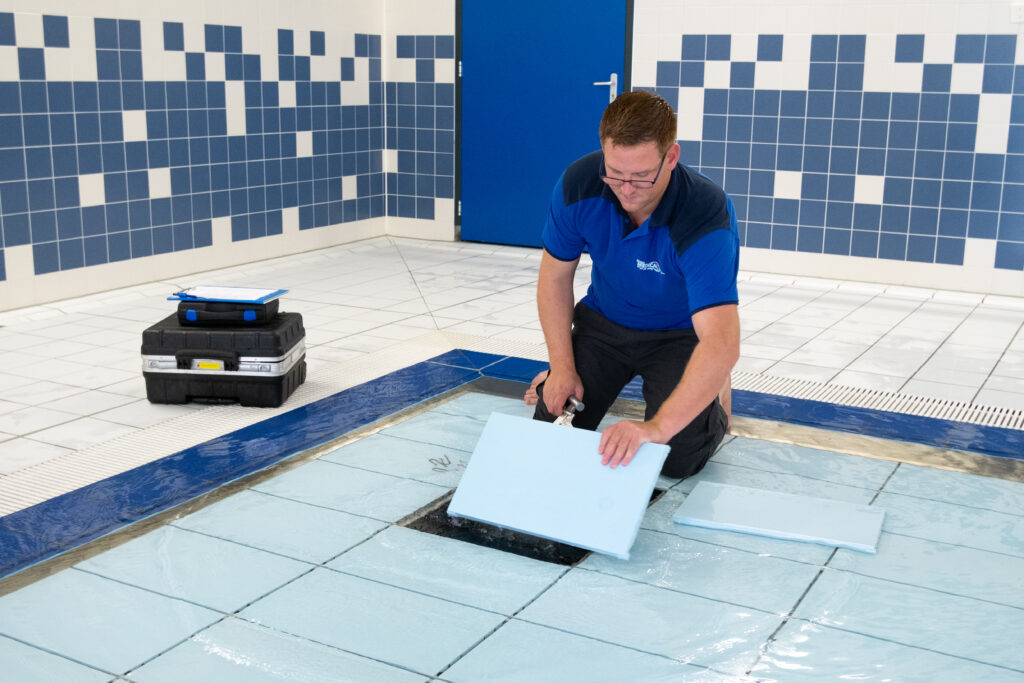Article Based on:
- *) Prins (1999) Aquatic therapy in the rehabilitation of athletic injuries
- Lambeck (2015) Proprioceptive and muscular training through therapeutic aquatic exercise in MSK rehabilitation
Authored by:
Introduction
The key to effective rehabilitation of sport injuries is the return to desired functional activity as soon as possible. Aquatic therapy provides a unique environment for promoting normal movement patterns and building strength early in the course of treatment. These changes usually are accomplished in the water, where the risk of further injury is reduced. This frequently is accompanied by a reduction in pain and perceived discomfort. Aquatic therapy in many cases is the only option for rehabilitation when land-based programs have not provided satisfactory results. *)
In this article we will point out the specific benefits of Aquatic Therapy rehabilitation for sports related injuries, based on a long list of research articles that have been published on this topic.
This article contains practical information informing physiotherapists how and where to apply exercises depending on the injury of the sports athlete.
Effects of the physical properties of water
- Direct effect: buoyancy
- Relief of the injury
- Indirect effect: Viscosity
- dependent on frontal surface and speed of movement
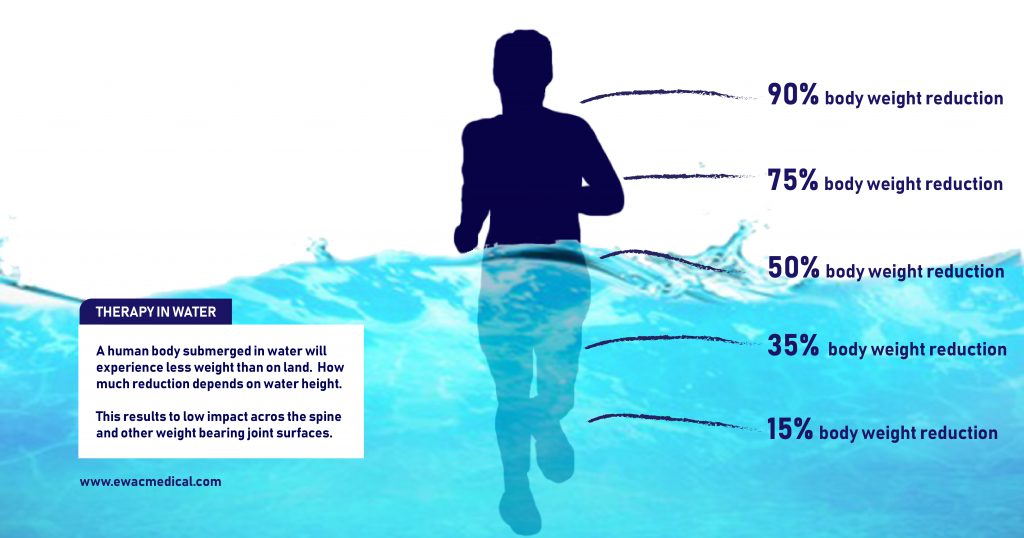
Relief of joints
- The degree to which the joints are relieved depends on the depth
- By varying the depth, the load can be accurately adjusted
- Varying depths can be chosen for running, hopping and jumping so that no overloading occurs in the recovery process
Muscle strengthening using viscosity
The three main advantages of muscle-strengthening exercises in water:
- Water offers an accommodating resistance, i.e. the resistance corresponds exactly to the applied force (F) and the delivered work (F*s). The risk of overloading or re-injury is therefore minimal.
- Water offers variable resistance. In contrast to isokinetic equipment, it is possible to vary the speed during movement. Because most human movements vary in speed by nature, functional improvements are more likely.
- Muscle strengthening exercises in water have the same freedom of movement as the joints allow. Training equipment limits freedom of movement and therefore agility. Exercises in water can be performed in such a way that they closely resemble the normal natural movement.
How to use the effects
Using buoyancy to improve mobility
- Shoulder conditions such as subacromial bursitis calcifying tendinitis
- Knee in rehabilitation after cruciate ligament repair
Simultaneous (symmetrical) exercise of upper and lower limbs
- This stimulates the affected limbs to achieve the same mobility and strength as the healthy limbs, thus restoring symmetry.
Cardiorespiratory fitness in water
- During the recovery period, significant fitness loss can occur. Therefore, resumption of training is essential to get back into the game. In water, training can be started fairly quickly to maintain fitness. Joint-relieving exercises such as “Deep water running” or cycling movements can be used for this purpose.
Early restoration of joint mobility
- Prolonged inactivity leads to muscle loss and loss of joint mobility, which in turn increases pain. Starting early with exercise in water maintains mobility and prevents loss of muscle
Recommended exercises in water
Shoulder and elbow:
- Movements from different positions and in different planes
- Using hand paddles to increase resistance
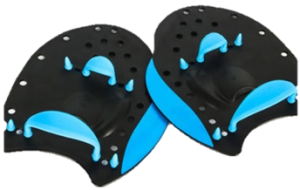
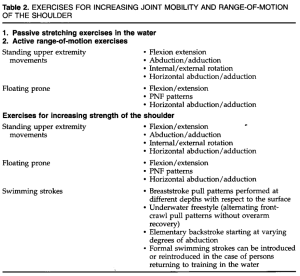
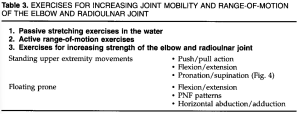
Cervical spine:
- Movement in vertical and horizontal positions
- Traction with floating neck collar
- PNF patterns, swimming movements
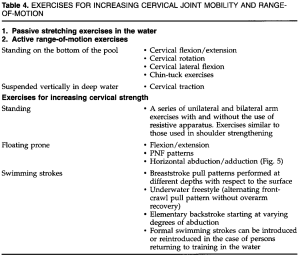
Lumbar spine:
- Unloaded movements in which back and abdominal muscles work together symmetrically: DWR (Deep Water Running)
- Traction with buoyancy aids
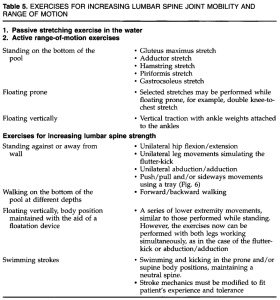
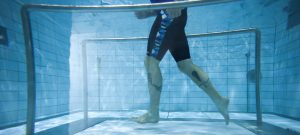
Knee:
- Positive results from comparative research into rehabilitation after ACL reconstruction:
- Less fluid accumulation
- Greater functional improvement
- Stronger increase in functional stability
- Walking at different depths, open chain exercises, muscle strengthening exercises
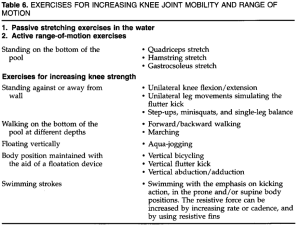
Hip, thigh and foot:
- Here, careful measurement of progression is essential
- Continuous evaluation of strength, mobility, posture, neurological integrity and function
- Exercise regime may be increased based on the progress of recovery
Appropriate selection of hydrotherapy
“Wet to dry”-transition
In cases where joints need strengthening before exercise in the hall, shortly after the injury has occurred
“Dry to wet”-transition
In cases where the client is overloaded during indoor exercises, a switch back to the water can be made. When the strength has been sufficiently restored, a switch back to the hall can be made.
“Wet only”
If the client has a strong preference for water-based therapy.
Conclusion:
Water offers a safe environment for rehabilitation in which the risk of re-injury is significantly reduced. In addition, muscle strength, joint mobility and fitness can be maintained in water while the client works on the recovery of his injured joints or muscles.
Hydrotherapy is in many cases the only remaining option if “dry” rehabilitation options have not led to the desired result.
Take me to the article:
- Prins (1999) Aquatic therapy in the rehabilitation of athletic injuries
- Lambeck (2015) Proprioceptive and muscular training through therapeutic aquatic exercise in MSK rehabilitation
